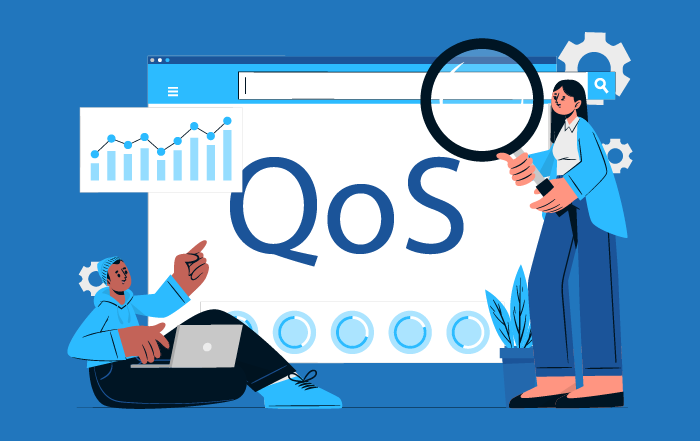Gain Visibility in Optimizing the Quality of Service
In an industry where the end-user experience is the ultimate benchmark, the Quality of Service (QoS) emerges as the backbone to revolutionize the...


In the fast-paced realm of the service industry, where seamless communication and data exchange are at the heart of operations, the role of technology cannot be overstated. As businesses and consumers alike rely more heavily on online platforms and real-time interactions, the quest for faster, more reliable, and more secure internet connectivity has grown more urgent. One technology has emerged as a beacon of transformation for the service industry: fiber optic infrastructure.
This blog will explore the economic advantages that fiber optic infrastructure presents to businesses operating within the service industry. In a landscape where timely decisions can be the difference between success and stagnation, investing in the right technological infrastructure has never been more critical. We will discuss the benefits that fiber optics brings – from unparalleled bandwidth and speed, to cost savings that echo over time, scalability that future-proofs operations, fortified data security, and the compelling potential to gain a competitive advantage and propel business growth. Through this, we illuminate the path for businesses to make informed decisions and harness the truly transformative potential of fiber optic infrastructure.
Fiber optic infrastructure, with its ability to transmit data using light signals, offers a quantum leap in data transfer rates compared to traditional copper-based systems. The result is a transformative enhancement of bandwidth and speed that can redefine the landscape of business operations. The implications are profound – imagine video conferences without stuttering screens, large file transfers completed in seconds, and cloud services operating without lag or interruption.
The advantages extend beyond the corporate sphere as well. Online gaming and video streaming platforms, for instance, benefit immensely from the increased speed and bandwidth that fiber optic infrastructure provides. Gamers experience minimal latency, leading to a smoother and more immersive gaming experience. Likewise, streaming services can deliver high-definition content in real time, eliminating buffering issues that can frustrate users and ensuring uninterrupted entertainment. In a world where speed and responsiveness are paramount, fiber optic infrastructure emerges as a pivotal solution that not only meets but anticipates the escalating demands of modern businesses and consumers alike. The economic gains from enhanced bandwidth and speed alone underscore the compelling argument for businesses to embrace this transformative technology as an investment in their future success.
While the initial investment in fiber optic infrastructure might seem substantial, it pales in comparison to the long-term economic benefits it offers. This forward-looking approach to connectivity pays off in numerous ways, making it an astute financial decision for businesses. The resilience of fiber optics against environmental factors, such as electromagnetic interference and corrosion, significantly reduces the need for ongoing repairs and replacements. As a result, businesses can expect reduced operational disruptions, minimizing costly downtimes that can impact productivity and revenue.
In essence, the cost savings associated with fiber optic infrastructure extend far beyond the initial investment, painting a compelling financial picture for businesses willing to adopt this technology. The prudent choice of investing in fiber optics not only leads to enhanced connectivity but also enables businesses to maximize their resources, streamline operations, and make strategic decisions with a long-term economic advantage in mind.
Fiber optic infrastructure offers a pivotal advantage in this regard, allowing businesses to seamlessly accommodate growing data demands without the need for extensive and costly infrastructure overhauls. Fiber optic networks are inherently designed for scalability. The immense data-carrying capacity of fiber optics ensures that as data requirements surge, the network can easily handle the load without compromising performance or speed.
Investing in fiber optics also equips businesses with a future-proof solution. With technology advancing at an unprecedented pace, businesses need infrastructure that can accommodate emerging technologies such as Internet of Things (IoT), artificial intelligence, and augmented reality. The scalability and future-proofing capabilities of fiber optics position businesses to navigate the digital evolution with confidence, making decisions rooted in long-term economic advantage and propelling growth in an ever-changing landscape.
The transition to fiber optic infrastructure offers a notable boost in this regard, solidifying its position as a future-proof investment. Fiber optic cables inherently offer enhanced data security compared to traditional copper cables. The very nature of fiber optics makes it exceptionally difficult to tap into the signals being transmitted. Fiber optic signals travel through thin strands of glass, rendering them nearly impossible to intercept without causing noticeable disruptions. This unique characteristic significantly reduces the risk of data breaches and cyberattacks.
Furthermore, the encryption capabilities of fiber optics add an extra layer of protection. Many industries are bound by strict data protection regulations, and the robust security offered by fiber optic infrastructure can help businesses meet these compliance mandates more effectively. As the digital landscape continues to evolve, and threats become more sophisticated, the adoption of fiber optic infrastructure not only ensures enhanced security but also gives companies a competitive edge in an increasingly data-driven world.
By providing businesses with faster, more reliable, and efficient connectivity, fiber optics can pave the way for remarkable growth and a significant competitive advantage. With fiber optic technology, companies can deliver seamless and lightning-fast customer experiences. This translates to improved customer satisfaction, as prompt and efficient services become the norm.
Moreover, the scalability and future-proofing aspects of fiber optic infrastructure allow businesses to adapt to growing demands effortlessly. As the business expands, the infrastructure can accommodate increased data needs without the need for major overhauls, saving both time and resources. In essence, investing in fiber optic infrastructure goes beyond connectivity; it’s an investment in the future of the business.
In a world where connectivity fuels innovation and growth, the economic advantages and long-term benefits of fiber optic infrastructure shine brightly. The potential for substantial cost savings in the long run, combined with the scalability and future-proofing capabilities of fiber optics, make it a strategic investment that aligns with the evolving needs of businesses.
Furthermore, the heightened data security offered by fiber optic infrastructure safeguards sensitive information, helping businesses comply with regulations and establish trust. This, in turn, leads to a competitive advantage, as faster, more reliable connectivity translates into improved customer experiences and satisfaction, fostering business growth and success. So, as you consider your next infrastructure investment, remember that fiber optics isn’t just about connectivity – it’s about unleashing your business’s full potential!

In an industry where the end-user experience is the ultimate benchmark, the Quality of Service (QoS) emerges as the backbone to revolutionize the...

As technology advances every day, the digital world becomes more competitive. There are many different tactics used to stay ahead of your current...

The demand for faster, more reliable, and secure internet connectivity has never been greater. Fiber optic technology, with its unparalleled speed,...